
Marie Curie was born in 1867 in Warsaw, Poland. Marie received much of her scientific education from her father but was unable to enrol at a formal university as woman. She and her sister attended the secret, underground “Flying University”. In 1891 Marie joined her sister in Paris, where she started her studies in physics, chemistry, and mathematics at the University of Paris (aka the Sorbonne). After graduating with a degree in physics, she worked as a researcher in an industrial laboratory, while simultaneously pursuing her second degree. She met her future husband Pierre Curie in 1894 and their love for research and science drew them together.
Marie and Pierre discovered two new elements between 1898 and 1902: polonium and radium. In 1903 the couple was awarded a Nobel Prize in physics, together with Henri Becquerel. In the same year Marie earned her doctorate in physics. Sadly, Pierre was killed in an accident in 1906. However, Marie continued working, and a few years later was awarded a second Nobel Prize, this time in chemistry for her work on measuring radioactivity. During World War I, she developed mobile x-ray machines named the “petites curies” (little Curies) which could be used at battlefronts. Marie died in 1934, aged 66, due to her long-term exposure to radiation. However, her legacy lives in on the numerous research institutes, hospitals, and prizes bearing her name.


